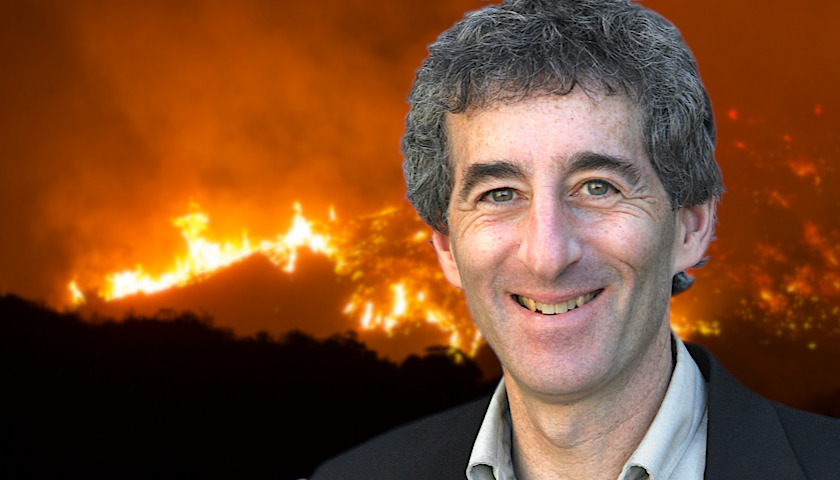by Michael Bastasch
– The Associated Press claims that “science says” global warming increases the area of western U.S. land scorched by wildfires every year.
– Climate scientist Cliff Mass noted AP’s simple correlation is not “science” and misses other key drivers of fires.
– It’s similar to another report from early August also attempting to link wildfires to global warming.
The Associated Press is out with an analysis claiming that “science says” the amount of western U.S. land scorched by wildfires every year increases as temperatures go up.
However, while those things are true, simply correlating two data trends is not “science,” as AP writer Seth Borenstein claims. And one expert says the simple correlation is meant to suggest a strong relationship between global warming and western wildfires that might not be there.
“This is not science,” University of Washington climate scientist Cliff Mass told The Daily Caller News Foundation.
The AP’s analysis found the “five years with the most acres burned since 1983 averaged 63.4 degrees from April to September,” which is “1.2 degrees warmer than average and 2.4 degrees hotter than the years with the least acres burned.”
Since 1999, “10 years have had more than 10,000 square miles burned, including 2017, 2015 and 2006 when more than 15,000 square miles burned,” the AP found. “Nationally, more than 8,900 square miles have burned this year, about 28 percent more than the 10-year average as of mid-August.”
However, the simple correlation between temperature and wildfires is meant to play into a broader media narrative that global warming is the main driver of fires, but Mass noted that other factors, including land management, play an important role.
“Correlation is not causation,” Mass said. “Temperatures are warming, that is true. Wildfire area in increasing in parts of the west, also true. But one does not necessarily cause another.”
“Wildfire area could well be increasing because of previous fire suppression, mismanagement of our forests, and a huge influx of people into the west, lightning fires and providing lots of fuel for them,” Mass said.
Most fires are human-caused, including 95 percent of fires in California, according to recent research. Sparks from vehicles, chainsaws and generators can set off massive blazes, as can power lines colliding with dried-out vegetation. Arson is the cause of many fires.
As the population of the West spreads into fire-prone landscapes, so does the risk of human-caused fires. Wildfire season is longer and more widespread in part because of an increased human presence in areas already prone to burning.
“I should note that there is a deep literature for California fires showing a very weak correlation between summer temperatures and wildfires,” Mass said. “If Borenstein had written up his ‘study’ and submitted it for publication, it would have been quickly rejected.”
Interior Secretary Ryan Zinke said that while climate change is a factor in drying out vegetation, the fact that officials aren’t clearing fuel from public lands is letting fires grow to catastrophic proportions.
The AP’s analysis correlating temperature with areas burned by wildfire is nearly identical to a “fact check” published about two weeks earlier by the website Carbon Brief.
The site argued “there is a strong relationship between temperature and fire extent, with warmer years generally having higher fire extent than relatively cooler ones since the early 1980s.”
Like The AP, Carbon Brief only looked at data from 1983 onward. Author Zeke Hausfather said that’s because data before then is unreliable, noting the U.S. Forest Service estimates of massive wildfires in the 1930s and 1940s were “double counted two or three times.”
U.S. Forest Service estimates are often cited to show wildfires were much worse in the past, suggesting land management is a major factor in keeping large fires in check. So does that mean all data prior to 1983 should be ignored?
Probably not. State-level data for lands under their jurisdiction also suggests massive wildfires burned in the 1930s and 1940s comparable, or even larger, than today’s fires. That trend is exemplified in data presented by the Oregon Department of Forestry.
State level data does show massive fires before 1950. Oregon state records show a similar trend to the USFS estimates going back to the early 1900s. Reminder: there was less CO2 in the 1930s. GASP! pic.twitter.com/cyg0sVnTll
— Mike Bastasch (@MikeBastasch) August 19, 2018
University of Colorado professor Roger Pielke Jr., who also studies natural disaster statistics, criticized the Carbon Brief article for presenting the data in such a way to overstate the importance of climate in wildfires.
https://twitter.com/RogerPielkeJr/status/1027590711925923841
– – –
Michael Bastach is a reporter at Daily Caller News Foundation. Follow Michael on Facebook and Twitter.
Image: “La Tuna Wildfire” by Scott L




